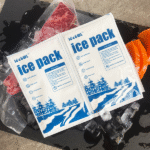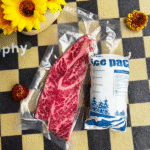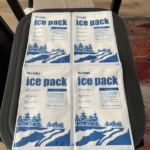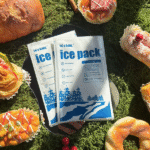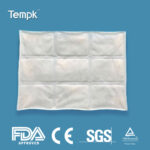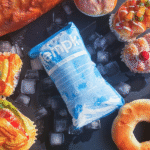What Is Cold Chain Temperature Control and Why Is It Important?
Cold chain temperature control refers to maintaining specific temperature ranges throughout the handling, storage and transport of temperature sensitive goods. Unlike ambient logistics, cold chain systems must preserve precise conditions across manufacturing, warehousing, transportation and last mile delivery. Typical temperature zones include controlled room temperature (20–25 °C), refrigerated ranges (0–8 °C), frozen ranges (–20 °C) and ultra low temperatures (–60 °C to –150 °C) for biologics and cell therapies.
Why Temperature Control Matters
Keeping products within their required temperature range prevents spoilage, potency loss and regulatory violations. In 2025, cold chain failures remain costly:
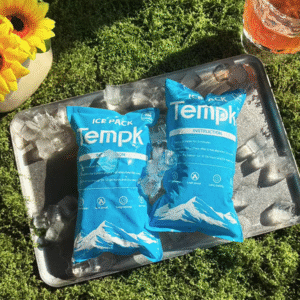
Food loss: The U.S. Department of Agriculture estimates up to one third of food is wasted in the United States.
Pharma waste: Even minor temperature excursions can invalidate vaccines; some biologics lose potency after a single hour outside +8 °C, leading to expensive recalls.
Economic impact: Global cold chain losses result in billions of dollars in wasted goods each year. International trade programs such as the UK Dairy Export Programme emphasize exports worth over USD 2.47 billion annually, underscoring the value of safeguarding perishable goods.
With stricter regulations and soaring demand for perishable goods, temperature control has become a strategic imperative rather than a niche function.
How Does a Temperature Control System Work?
A robust cold chain system combines hardware, software and processes to monitor and maintain temperature integrity from origin to destination. Key components include:
| Component | Purpose | Example Technology | What it means for you |
| Refrigeration equipment | Provides cooling for storage and transport. Includes compressors, condensers and evaporators. | Copeland’s ZB and CF scroll compressors offer high efficiency and handle low GWP refrigerants. | Upgrading to modern compressors can deliver up to 8 % higher capacity and better energy efficiency. |
| Temperature sensors & data loggers | Record temperature and humidity over time. Data loggers provide historical records; IoT sensors enable real time alerts. | GO trackers and wireless loggers monitor temperature, location and humidity and consolidate data in a cloud portal. | Real time alerts help you intervene before spoilage occurs. |
| Smart packaging | Protects goods during transport and insulates against ambient temperature. | Vacuum insulated panels (VIPs), phase change materials and gel packs maintain set temperatures without continuous power. | Reduces reliance on mechanical refrigeration during transit. |
| Monitoring platforms | Consolidate sensor data, provide dashboards and generate compliance reports. | Cloud portals integrated with AI deliver predictive maintenance and automated documentation. | Simplifies compliance with HACCP and GDP and provides audit ready reports. |
| Power systems | Provide energy to refrigeration equipment; essential for remote or mobile units. | Solar power and battery storage reduce reliance on grid electricity. | Lowers operating costs and ensures resilience during outages. |
Practical Tips and Advice
Choose sensors based on your data needs: Data loggers are affordable for historical audits, while IoT sensors offer real time alerts. In high value shipments, combine both to balance cost and coverage.
Map your temperature zones: Identify which stages require refrigeration, freezing or ultra cold conditions. Use multi zone trucks and warehouses to avoid over cooling everything.
Invest in modern compressors: Replace outdated refrigeration units with high efficiency, low GWP compressors like Copeland’s ZB and CF series for improved capacity and lower emissions.
Case example: At a 268,000 square foot cold storage facility in Maryland, operators installed solar panels producing over 2.5 million kWh of renewable energy annually. The project reduced grid reliance and cut energy costs while maintaining consistent freezer temperatures.
Advanced Technologies Shaping Temperature Control in 2025
AI Powered Route Optimization
Artificial intelligence is transforming logistics by analysing traffic patterns, weather conditions and delivery windows to adjust routes in real time. AI powered route optimization improves efficiency, reduces fuel consumption and enhances delivery reliability. Combined with IoT sensors, AI algorithms detect potential temperature excursions and recommend corrective actions before goods are compromised.
Blockchain for Enhanced Traceability
Blockchain creates immutable records of product journeys, providing end to end visibility and preventing data tampering. By storing temperature readings and location data on a distributed ledger, blockchain ensures transparency, compliance with food safety regulations and consumer trust.
IoT Enabled Monitoring & Predictive Analytics
IoT sensors continuously track temperature, humidity, shock and door events across trucks and warehouses. Real time data allows immediate corrective actions when deviations occur, while predictive analytics uses historical patterns to anticipate equipment failures and route risks.
Low GWP Refrigerants & Refrigeration Innovation
Regulations are phasing out high global warming potential (GWP) refrigerants. Modern systems adopt CO₂ (R 744), propane (R 290) and new A2L refrigerants to reduce environmental impact. Copeland’s CF series compressors support A2L and A3 refrigerants, delivering high capacity with reduced emissions. Oil free centrifugal compressors eliminate lubricating oil, further improving efficiency.
Solar Powered Cold Rooms & Renewable Energy
Energy intensity is a major challenge—refrigeration can account for up to 70 % of total energy use in cold storage facilities. Solar powered cold rooms with scroll inverter technology provide renewable energy in remote areas, ensuring consistent cooling while reducing energy costs. Battery storage systems smooth out fluctuations and provide backup during peak demand periods.
Smart Shipping Containers & Sustainable Packaging
Lightweight, insulated shipping containers equipped with IoT sensors track temperature, humidity and location in real time. Sustainable packaging solutions use recyclable materials to minimize environmental impact while maintaining insulation. Phase change materials and dry ice monitors maintain ultra cold conditions (–80 °C to –150 °C) for biologics and cell therapies.
Table: Comparing Temperature Control Technologies
| Technology | Key Benefit | Limitation | Real World Use |
| IoT sensors & cloud dashboards | Continuous real time monitoring; predictive analytics; automated alerts | Dependence on network connectivity; data security concerns | High value shipments and cross border logistics |
| Blockchain | Immutable record of temperature and location; improves traceability | Requires stakeholder adoption; transaction costs | Pharmaceuticals requiring strict compliance |
| Solar powered cold rooms | Reduce energy costs; provide cooling in remote areas | High upfront investment; reliant on sunlight | Rural farms or clinics with unreliable grid power |
| Low GWP refrigeration systems | Lower greenhouse emissions; future proof against regulations | May require equipment replacement; limited availability in some regions | New warehouses and retrofits |
| Smart containers & sustainable packaging | Provide real time data and reduce packaging waste | Higher cost; may require specialized handling | International shipping of pharmaceuticals or seafood |
Selection Tips
Evaluate environmental impact: Choose low GWP refrigerants and sustainable packaging to meet corporate ESG goals.
Adopt hybrid monitoring: Combine data loggers with IoT sensors to balance cost and real time visibility.
Look for AI integration: Predictive maintenance reduces unplanned downtime and extends equipment lifespan.
Prioritize data security: Use encryption, access controls and regular updates to protect sensitive temperature and location data.
Navigating Regulatory Requirements
Temperature control is governed by a patchwork of international, regional and industry specific regulations. Understanding these frameworks is essential for compliance and market access.
International & Regional Regulations
HACCP and Food Safety Regulations: EU Regulation EC 852/2004 mandates hygiene duties and HACCP based procedures. The European Commission’s 2022 guidance on Food Safety Management Systems (FSMS) embeds food safety culture and harmonizes implementation.
Good Distribution Practice (GDP): EU GDP guidelines require risk based temperature control, route planning to minimize thermal risk, and calibrated monitoring devices with secure records. Pharmaceutical shipments must demonstrate continuous temperature control and provide documentation for audits.
ATP Agreement: The UNECE ATP framework sets performance classes for insulated and refrigerated road equipment, specifying thermal performance for multi stop routes and cross border movements.
Energy & Sustainability Directives: The EU’s F gas Regulation (EU 2024/573) accelerates the phase down of high GWP refrigerants, pushing cold stores towards CO₂ and hydrocarbons. The Energy Performance of Buildings Directive requires “zero emission buildings” and solar readiness for new warehouses, while the Energy Efficiency Directive embeds the “energy efficiency first” principle.
CSRD & ESG Reporting: The Corporate Sustainability Reporting Directive (CSRD) demands granular, audited energy and climate data from logistics operations, beginning with large listed companies.
Compliance Best Practices
Validate equipment: Perform installation (IQ), operational (OQ) and performance (PQ) qualification for all temperature controlled equipment.
Temperature mapping: Conduct mapping studies to identify hot and cold spots in cold rooms, freezers and trucks.
Document everything: Maintain continuous monitoring records, deviation investigations and corrective actions.
Qualify partners: Audit logistics providers and packaging vendors to ensure they meet temperature control requirements and have contingency plans.
Train staff: Develop SOPs and train personnel on temperature control, monitoring protocols and emergency procedures.
Practical Advice
Use cloud dashboards to generate audit ready reports and share temperature logs with regulators and clients.
Plan for redundancy: Deploy backup generators, secondary refrigeration units and disaster recovery plans to maintain temperature during outages.
Stay updated: Monitor evolving regulations, including low GWP refrigerant transitions and energy performance mandates.
Sustainability & Energy Efficiency Strategies
Energy accounts for the lion’s share of operating costs in cold storage. Refrigeration consumes up to 70 % of total energy use, and facilities may use approximately 25 kWh per square foot annually for cooling. With energy costs rising, operators are adopting strategies to cut consumption and emissions.
Renewable Energy & Solar Integration
Installing solar panels reduces dependence on the grid and provides predictable energy costs. In the Jessup Cold Storage Solar Project, a 268,000 sq ft facility generates over 2.5 million kWh of renewable energy annually. Solar plus battery storage allows facilities to manage peak demand and participate in demand response programs, earning incentives up to $100 per kW annually.
High Efficiency Refrigeration & Inverter Technology
Modern compressors use inverter technology to adjust output based on load, improving seasonal energy efficiency. Copeland’s scroll inverter technology offers up to 8 % capacity advantage and integrates with solar power for remote cold rooms.
Zoned Temperature Control & Smart Facility Design
Zoning ensures only areas that need cooling are refrigerated, reducing energy waste. High efficiency HVAC systems, optimized slotting and reduced dwell time in warehouses cut energy consumption. Smart building management systems automatically adjust airflow, lighting and refrigeration based on real time conditions.
Sustainable Packaging & Recyclable Materials
Sustainable packaging not only protects goods but reduces environmental impact. Manufacturers adopt recyclable insulated containers, biodegradable thermal wraps and reusable pallets to minimize waste. Some companies are experimenting with raising standard freezer temperatures from –18 °C to –15 °C to reduce energy consumption without compromising food safety.
Advice for Energy Efficiency
Conduct energy audits: Identify inefficiencies and prioritize upgrades.
Retrofit old equipment: Replace legacy refrigeration units with low GWP, high efficiency models.
Leverage incentives: Explore state or regional incentives for renewable energy and energy efficiency improvements.
Measure & report: Use sustainability metrics to track progress and satisfy CSRD and ESG reporting requirements.
Market Trends & Growth Projections
The cold chain sector is growing rapidly across multiple segments:
Cold chain logistics market: Valued at USD 341 billion in 2024, it is forecast to reach USD 1.19 trillion by 2034 (CAGR 15.3 %).
Cold chain monitoring market: Estimated at USD 45.19 billion in 2025, projected to reach USD 266.66 billion by 2034 (CAGR 21.88 %). The hardware component accounts for 79 % of revenues, while software grows at 23.72 %.
Food cold chain market: Expected to be USD 65.8 billion in 2025 and reach USD 205.3 billion by 2032 (CAGR 17.5 %). Frozen foods account for over 59.7 % of food cold chain volume, emphasizing the need for low temperature control.
Energy intensive operations: Cold chain facilities use about 4–5 times more energy than standard commercial buildings, with refrigeration representing up to 70 % of energy use. Operators are investing heavily in renewable energy, battery storage and energy efficiency to remain competitive.
Market Drivers
E commerce & online grocery: The e commerce logistics market reached USD 426.2 billion in 2023, growing more than 14 % annually. Online grocery sales increased by 14.2 %, driving last mile cold chain demand.
Global trade & exports: International trade of perishable goods is expanding; the US baked goods exports reached USD 4.21 billion in 2022, up from USD 3.73 billion in 2021. UK government programs support dairy exports valued at over USD 2.47 billion.
Urbanization & QSR growth: Rapid urbanization and the rise of Quick Service Restaurants (QSRs) are accelerating cold chain demand in markets like India, where daily milk consumption averages 427 g per capita, well above the global average. The Indian QSR sector is expected to grow 20–25 % in fiscal year 2024.
Regulatory pressure: Stricter food safety laws and GDP requirements compel businesses to adopt real time monitoring and traceability solutions.
Key Players & Innovations
Major cold chain companies like Americold Logistics, Lineage Logistics, Nichirei, Burris Logistics and A.P. Moller Maersk are investing in digital monitoring, renewable energy and low emission vehicles. Technology providers such as Copeland are launching compressors with AI diagnostics, mobile apps and low GWP refrigerants to drive efficiency.
Challenges & Solutions in Temperature Control
Challenges
High energy costs: Cold storage facilities consume 4–5 times more electricity than standard buildings. Energy volatility exposes operators to significant cost risk.
Infrastructure gaps: Remote regions often lack reliable power or road infrastructure, causing 25 % of temperature excursions during last mile delivery.
Implementation costs: Comprehensive IoT monitoring systems can cost over USD 50,000 per distribution center. Small businesses may struggle to justify the investment.
Regulatory complexity: Fragmented standards across regions increase compliance costs by 15–20 %.
Data security: IoT devices and cloud platforms pose cybersecurity risks if not properly secured.
Solutions
Hybrid monitoring strategies: Use a combination of data loggers and IoT sensors to control costs while capturing real time data.
Edge computing: Process data locally on devices to trigger alerts in areas with poor connectivity.
Predictive maintenance: Employ AI to forecast equipment failures and schedule maintenance proactively.
Modular cold storage: Deploy portable, solar powered cold rooms with low GWP refrigerants to serve remote areas.
Training & change management: Provide staff training on interpreting dashboards, responding to alerts and maintaining equipment.
Real world example: A mid size dairy cooperative installed IoT sensors in refrigerated trucks. During a summer heatwave, sensors detected a temperature deviation; the system sent instant alerts, enabling drivers to adjust refrigeration and prevent spoilage. The cooperative reported a 15 % reduction in product loss and improved compliance documentation.
Emerging Innovations & Real World Cases
Solar Powered Cold Rooms & Remote Farms
Remote areas often lack reliable power, jeopardizing temperature control. Copeland’s scroll inverter technology enables solar powered cold rooms that deliver high energy efficiency and stable temperatures. In rural India, solar cold rooms equipped with Copeland compressors allow farmers to store produce locally, reducing spoilage and improving income.
Low GWP Refrigeration & AI Diagnostics
Transitioning to low GWP refrigerants like CO₂ and propane reduces emissions and ensures future compliance. AI diagnostics embedded in mobile apps (e.g., Copeland’s Scout AI) allow technicians to scan a product and receive instant troubleshooting guidance, reducing downtime and energy waste.
Portable Cryogenic Freezers
Portable freezers maintain ultra low temperatures between –80 °C and –150 °C for biologics and cell therapies. Their compact design facilitates safe transport to remote clinics or research sites.
Sustainable Packaging & Reusable Systems
Eco friendly packaging materials and reusable insulated containers reduce waste and support ESG goals. Innovations in smart containers integrate temperature sensors directly into packaging, enabling real time monitoring without extra devices.
Digital Dashboards & Client Visibility
Modern warehouses feature web based dashboards providing live inventory visibility, expiration tracking, FEFO (First Expired, First Out) logic and automated alerts. Clients can access data remotely, enhancing transparency and trust.
Market Impact
These innovations help reduce waste, improve compliance and drive sustainability. They also enable new business models, such as subscription based monitoring services and pay per use cold rooms for small producers.
2025 Latest Developments and Trends
Trend Overview
2025 signals a shift toward predictive, sustainable and integrated temperature control systems. Key developments include:
AI & predictive route optimization: Real time AI adjusts delivery routes based on traffic and weather, reducing fuel consumption and preventing temperature excursions.
Blockchain traceability: Supply chains adopt blockchain for tamper proof records, ensuring compliance and consumer trust.
Solar powered solutions: Solar refrigerated units and solar battery storage cut energy costs and increase resilience, particularly in remote areas.
Low emission vehicles: Electric and hybrid refrigerated trucks, along with energy efficient transport refrigeration units (eTRUs), support compliance with CO₂ reduction targets.
Sustainable packaging: Eco friendly materials meet consumer demand and regulatory requirements.
Growth of micro fulfillment: Small, multi temperature warehouses near urban centers accelerate e commerce deliveries.
Latest Progress at a Glance
Composite sensors integrate temperature, humidity and shock data with AI algorithms, offering deeper insights and predictive maintenance.
Edge computing reduces latency by processing sensor data locally, enabling faster reactions to temperature deviations in areas with poor connectivity.
Advanced materials: New insulation materials such as aerogels and bio based foams provide superior thermal performance with lower environmental impact.
Policy changes: The EU F gas Regulation and Energy Performance Directives accelerate adoption of low GWP refrigerants and zero emission buildings.
Market Insights
Regional growth: Asia Pacific is the fastest growing cold chain market due to rising incomes, urbanization and government investment. North America maintains the largest market share in 2025.
Hardware vs. software: Hardware accounts for 79 % of cold chain monitoring revenues but software adoption is rising as AI and analytics become standard.
Frozen foods & e commerce: Frozen foods account for over 59.7 % of food cold chain volume and e commerce growth amplifies demand for last mile cold chain logistics.
Market Forecast Table
| Segment | 2025 Value | 2034/2032 Forecast | Growth Driver |
| Cold chain logistics | USD 341 billion | USD 1.19 trillion by 2034 | E commerce, global trade, pharma |
| Cold chain monitoring | USD 45.19 billion | USD 266.66 billion by 2034 | IoT sensors & AI |
| Food cold chain | USD 65.8 billion | USD 205.3 billion by 2032 | Rising demand for frozen & fresh foods |
| Frozen foods share | 59.7 % of volume | Growing with frozen meals & seafood | Need for precise low temperature control |
Frequently Asked Questions
What temperature ranges define cold chain temperature control? Depending on the product, cold chain temperature zones range from controlled room temperature (20–25 °C) to refrigerated (0–8 °C), frozen (–20 °C) and ultra low temperatures for biologics (–60 °C to –150 °C).
How do IoT sensors improve temperature control? IoT sensors provide continuous, real time monitoring of temperature, humidity, shock and location. They transmit data to cloud platforms, where AI analyzes patterns and predicts failures, enabling proactive interventions and regulatory compliance.
Why is AI powered route optimization important? AI can adjust delivery routes based on real time traffic and weather, reducing transit time, fuel consumption and risk of temperature excursions.
What role does blockchain play? Blockchain technology creates immutable records of temperature and location, enhancing traceability, compliance and consumer trust.
How can businesses reduce cold chain energy costs? By installing solar panels, using inverter compressors, adopting zoned temperature control and integrating battery storage, businesses can reduce energy consumption and mitigate price volatility.
What are low GWP refrigerants? Low GWP refrigerants such as CO₂ (R 744), propane (R 290) and A2L blends have significantly lower climate impact than traditional HFCs. Transitioning to these refrigerants helps meet environmental regulations and reduces carbon emissions.
Are portable cryogenic freezers available? Yes. Compact portable freezers can maintain ultra low temperatures (–80 °C to –150 °C) for biologics and cell therapies, making them ideal for remote clinics and research shipments.
Summary & Recommendations
Cold chain temperature control is the foundation of safe and efficient logistics. The market is booming—cold chain logistics is expected to exceed USD 1 trillion by 2034—and regulations are tightening. Emerging technologies like IoT sensors, AI, blockchain, solar power and low GWP refrigerants are transforming how we monitor and maintain temperature.
To stay ahead in 2025:
Audit your supply chain: Identify where temperature excursions occur and prioritize monitoring investments.
Deploy real time monitoring: Use IoT sensors and cloud dashboards to capture continuous data.
Leverage AI: Implement predictive analytics to forecast equipment failures and optimize routes.
Adopt sustainable solutions: Invest in energy efficient refrigeration, solar power and low GWP refrigerants.
Ensure compliance: Document temperature history, validate equipment and train staff to meet HACCP, GDP and ATP standards.
Plan for resilience: Prepare contingency plans with backup power, secondary refrigeration units and disaster recovery procedures.
By embracing technology, sustainability and compliance, you can protect product quality, reduce waste and position your business for success in the rapidly evolving cold chain landscape of 2025.
About Tempk
Tempk is a leader in thermal management and cold chain solutions. We specialize in designing energy efficient compressors, smart sensors, reusable packaging and cloud platforms that keep temperature sensitive goods safe. Our products use low GWP refrigerants, AI diagnostics and renewable energy integration to deliver high efficiency and reliability. With decades of experience across food, pharmaceutical and biotechnology sectors, Tempk helps businesses reduce waste, achieve regulatory compliance and meet sustainability goals.
Call to Action
Ready to optimize your cold chain temperature control? Contact Tempk today for a customized assessment. Our experts will help you implement IoT monitoring, AI analytics, energy efficient refrigeration and sustainable packaging tailored to your operations. Protect your products and reduce costs—partner with Tempk.

















